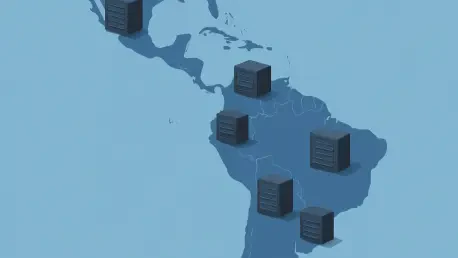Latin America, historically perceived as a mere consumer of global digital services, is now experiencing a seismic shift as it emerges as a pivotal hub for data center infrastructure, fueled by an insatiable demand for advanced computing power. This transformation, particularly driven by artificial intelligence (AI), is redefining how businesses and societies operate. Beyond technology, this boom is reshaping economic landscapes, influencing government policies, and even prompting a reevaluation of environmental priorities across the region. The numbers are staggering—Latin America’s data center market is projected to double to $10 billion by 2029, according to the Inter-American Development Bank, while currently accounting for 4.8% of the world’s data centers. This growth positions the region to capture a substantial share of global demand, expected to rise by 19% to 22% annually through 2030. As tech giants and local governments align to capitalize on this momentum, Latin America stands at a crossroads of opportunity and challenge in the global digital economy.
Drivers of the Data Center Surge
AI and Computing Demand
The meteoric rise of AI applications serves as a primary catalyst for the unprecedented growth of data centers in Latin America. As AI becomes deeply integrated into business operations and daily life, the need for immense computational power and state-of-the-art facilities has skyrocketed. Industry experts, such as Cesar D’Onofrio, CEO of Making Sense, liken AI’s transformative potential to that of the internet, emphasizing how it can empower smaller companies to gain a competitive edge through enhanced efficiency. This technological wave demands data centers capable of handling vast datasets and complex algorithms, positioning Latin America as a critical player in meeting these global needs. The region’s ability to support such infrastructure not only addresses current demands but also sets the stage for future innovations that could redefine entire industries.
Moreover, the ripple effects of AI-driven demand extend beyond mere infrastructure to influence economic and social dynamics in Latin America. The push for advanced computing resources is creating a surge in job opportunities within the tech sector, ranging from construction to high-skilled IT roles. This economic uplift, however, comes with a caveat—ensuring that local talent is equipped to handle these sophisticated systems remains a priority. Governments and private entities are beginning to invest in training programs to bridge this skills gap, recognizing that sustainable growth hinges on a workforce capable of supporting this digital evolution. As AI continues to drive data center expansion, Latin America finds itself at the forefront of a technological renaissance with far-reaching implications.
Strategic Location and Policies
Latin America’s geographic proximity to the United States offers a strategic advantage that bolsters its appeal as a data center hub. This closeness facilitates nearshoring trends, allowing companies to enhance supply chain reliability and reduce latency for North American markets. Additionally, data localization laws in nations like Brazil, Mexico, and Argentina mandate that sensitive information be stored within national borders, compelling global tech giants to establish local facilities. These regulations are not merely bureaucratic hurdles but pivotal drivers pushing significant investments into the region. The alignment of location and policy creates a compelling case for Big Tech to prioritize Latin America over more distant alternatives.
Further enhancing this trend are proactive government initiatives designed to attract digital infrastructure investments. Chile’s National Data Centers Plan, supported by a $2.5 billion commitment, exemplifies how policy can shape a country’s role in the global tech ecosystem. Such frameworks provide incentives and infrastructure support, making it easier for companies to set up operations. This governmental backing, combined with the region’s strategic positioning, ensures that Latin America is not just a passive recipient of tech expansion but an active participant shaping its digital future. The synergy of these factors underscores why the region is becoming indispensable to the plans of major technology corporations worldwide.
Opportunities for Growth and Innovation
Economic and Technological Advancement
The data center boom in Latin America heralds a new era of economic growth and technological progress that could redefine the region’s global standing. Ambitious projects, such as Brazil’s “Rio AI City,” which aims to achieve a capacity of 1.8GW by 2027, highlight the scale of investment and vision driving this transformation. This initiative alone positions Brazil as a potential leader in the global tech ecosystem, creating a ripple effect of job creation and industrial development. Beyond immediate economic benefits, the presence of cutting-edge infrastructure fosters an environment ripe for local innovation, enabling startups and enterprises to leverage data-intensive applications that were previously out of reach. This shift marks a departure from the region’s traditional role as a consumer to that of a producer in the digital economy.
Equally significant is the potential for technological advancement to bridge longstanding economic disparities within Latin America. As data centers proliferate, they bring with them the promise of connectivity and access to digital tools that can empower underserved communities. Governments and companies are increasingly recognizing the importance of inclusive growth, ensuring that the benefits of this boom extend beyond urban centers to rural areas. This focus on equitable development could catalyze broader societal improvements, from education to healthcare, by integrating advanced technologies into public services. As Latin America harnesses this wave of digital infrastructure, the opportunity to redefine its economic narrative becomes not just a possibility but an imperative for sustainable progress.
Leveraging Renewable Energy
Latin America’s abundant access to renewable energy resources provides a distinctive advantage in the global race for sustainable data center expansion. Countries like Brazil and Chile lead the charge, with Brazil hosting a substantial share of clean industrial projects and Chile boasting an energy grid that is 91% carbon-free, as noted in Google’s 2024 Environmental Report. This clean energy profile allows tech companies to align their infrastructure growth with stringent global sustainability goals, reducing the carbon footprint of data-intensive operations. By prioritizing renewable sources, the region sets a benchmark for how digital expansion can coexist with environmental stewardship, offering a model that other regions might emulate in their own tech journeys.
This focus on sustainability also enhances Latin America’s attractiveness to environmentally conscious investors and corporations. Tech giants are under increasing pressure to demonstrate commitment to green practices, and the region’s natural advantages provide a compelling solution. Initiatives to power data centers with wind, solar, and hydroelectric energy not only mitigate environmental impact but also reduce operational costs in the long run. However, maximizing this potential requires continued investment in energy infrastructure to ensure reliability and scalability. As Latin America balances its renewable energy strengths with the demands of digital growth, it stands poised to lead by example in creating a tech ecosystem that prioritizes both innovation and ecological responsibility.
Challenges and Concerns
Resource Strain and Environmental Impact
The rapid proliferation of data centers in Latin America, while a boon for technological advancement, places immense strain on local resources, raising critical environmental concerns. These facilities demand substantial amounts of power, water, and land, often overwhelming existing systems in resource-scarce areas like Querétaro, Mexico. Local communities are voicing concerns about water shortages exacerbated by the needs of tech giants like Amazon and Microsoft, highlighting a growing tension between industrial growth and basic human needs. Public opposition, such as the pushback against Google’s $200 million project in Chile, has forced companies to rethink their approaches, integrating stricter environmental standards to address community grievances. This dynamic underscores the urgent need for strategies that mitigate resource depletion while supporting digital expansion.
Additionally, the environmental footprint of data centers extends beyond immediate resource use to broader ecological impacts. The construction and operation of these facilities can disrupt local ecosystems, contributing to habitat loss and pollution if not managed carefully. Governments and corporations are beginning to face scrutiny over how they balance these trade-offs, with calls for transparent impact assessments growing louder. In regions like Chile and Brazil, where natural landscapes are integral to national identity, the stakes are even higher. Addressing these challenges requires innovative solutions, such as advanced cooling technologies to reduce water usage and partnerships with local stakeholders to ensure that development does not come at the expense of environmental integrity. The path forward hinges on a commitment to responsible growth that respects both nature and community needs.
Balancing Progress and Sustainability
While the economic and technological benefits of the data center surge in Latin America are undeniable, achieving sustainability remains a pressing and complex challenge. Tech giants are taking initial steps to address these concerns—Google, for instance, revised its plans in Chile to minimize water usage after public outcry—but such actions are just the beginning. Long-term success depends on robust resource management strategies that prioritize efficiency and conservation. This includes adopting cutting-edge technologies to reduce energy consumption and ensuring that new facilities are designed with environmental impact in mind. Without such measures, the region risks undermining the very growth it seeks to achieve, as resource depletion could lead to both economic and social backlash over time.
Moreover, collaboration between governments, companies, and local communities is essential to strike a balance between progress and sustainability. Policies must be crafted to enforce environmental standards without stifling investment, while community engagement ensures that local voices shape development priorities. In Brazil, debates over resource allocation for projects reportedly tied to major tech players highlight the need for transparent dialogue to address public concerns. As Latin America navigates this delicate equilibrium, the focus should be on creating a framework where digital infrastructure enhances quality of life without compromising future generations’ access to vital resources. Only through such integrated efforts can the region sustain its role as a global tech hub while safeguarding its environmental and social fabric.
Reflecting on a Digital Legacy
Looking back, Latin America’s journey into becoming a cornerstone of global digital infrastructure was marked by bold strides and intricate challenges. The region harnessed its strategic advantages, from geographic proximity to renewable energy wealth, to attract monumental investments in data centers. Yet, the path was fraught with hurdles, as resource strains and environmental concerns tested the resolve of both policymakers and corporations. Reflecting on this period, it’s evident that every step forward required a careful weighing of technological ambition against ecological and social responsibility. Moving into the future, the emphasis must shift toward actionable solutions—forging stronger public-private partnerships to innovate resource-efficient technologies and embedding sustainability into the core of digital expansion plans. Latin America’s legacy in this domain will be defined by how it navigated these complexities, setting a precedent for others to build a tech-driven world that thrives on balance and foresight.









